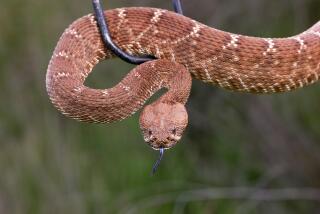It’s a snake! Monkey brains may explain our fear of reptiles
We’re not born with a fear of snakes, but it sure seems to develop early.
Now scientists may be closer to a explaining why ophidiophobia ranks among the top fears of humans, and seems to be shared with other primates.
Researchers inserted probes into the brains of Japanese macaques and found that neurons in a part of their brain that controls visual attention were more strongly and quickly activated in response to images of snakes, versus other objects.
The results, published online Monday in the journal Proceedings of the National Academy of Sciences, appear to support a theory that early primates developed advanced perception as an evolutionary response to being prey, not as an adaptation that may have made foraging or hunting easier.
Though fear of snakes may not be innate, noticing them more than other phenomena may be hard-wired by evolution, said Lynne Isbell, an evolutionary biologist from UC Davis and one of the authors of the paper. That heightened attention, research has shown, can lead to early and resilient learned behavior, such as fear-mediated avoidance. In other words, getting out of the way of snakes.
“The characteristics we have help us to see them better than other mammals can see them,” Isbell said. “Mammals in general are really good at picking up movement. But snakes lie in wait. They don’t move very much, so it’s crucial to see them before they see us and to avoid them.”
Developing new additions to the brain would have given ancestor primates an advantage. Many scientists assumed the advantage had to do with catching insects for food. But Isbell shook that view of primate evolution in 2006, eventually elaborating on it in a book, “The Fruit, the Tree and the Serpent: Why We see So Well.” An arms race between predator and prey is what selected for bigger-brained primates, Isbell argued.
“They were actually prey,” Isbell said “And the first of the modern predators of primates, and the most persistent, that continued to this day -- and that look the same as they did 100 million years ago -- are snakes.”
The brain addition that made all the difference for Old World monkeys was the pulvinar nuclei, according to Isbell. Those areas of the thalamus have been found to control such things as eye and head motions toward stimuli -- responses known as selective spatial attention.
Researchers were probing deep into the limbic system, a region of emotional processing and memory that sometimes is called the old mammalian brain. They inserted probes into the pulvinar nuclei. These nuclei receive inputs directly from the retina of the eye and also connect with nearby brain regions associated with threat-relevant behavior and emotional processing.
Electrical pulses from the pulvinar neurons occurred about 60 milliseconds after the snake was presented to the monkeys -- suggesting that the signal might be processed unconsciously. Another pulse came at about 250 milliseconds, and that could be associated with feedback from the cortex, where higher cognitive functions are controlled.
The researchers used two monkeys raised in captivity that had no opportunity to encounter a snake. Probes measured responses to snakes, faces and hands of monkeys, and geometric shapes. More neurons responded to the snakes, and did so with greater strength and speed, the data showed.
In addition to those at UC Davis, the research team included scientists from the University of Toyama in Japan and the Primate Center of the University of Brasilia in Brazil. It was supported by the Asian CORE program, which promotes research cooperation.
[For the Record, 10:58 a.m. PST: An earlier version of this post said electrical pulses from pulvinar neurons occured within microseconds. The correct order of magnitude is milliseconds.]







